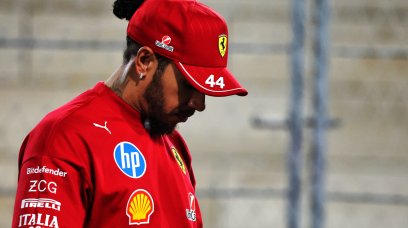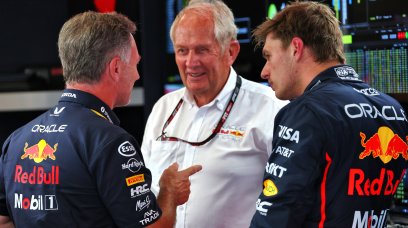The 2023 Australian Grand Prix set the record for the most red flags during a race in the history of Formula 1, after three were brought out by the end of the 58-lap saga. Prior to this the record was two red flags in a race, which happened during six events: 1981 Belgian Grand Prix, 1987 Austrian Grand Prix, 2014 Japanese Grand Prix, 2016 Brazilian Grand Prix, 2020 Tuscan Grand Prix, and 2021 Saudi Arabian Grand Prix. The FIA made use of a rule that was reintroduced in 2017 to increase the entertainment value, which enables them to have a standing restart over a Safety Car restart at the Race Director's discretion. Fernando Alonso blasted the procedure over team radio by calling it a "stupid rule" while Lando Norris claimed it was done "for the show." RacingNews365.com journalists Rory Mitchell and Jake Nichol debate whether F1 has gone too far with entertaining restarts.
Rory Mitchell - The teams got what they asked for
The unusual spectacle of F1 cars lining up for standing start for what is effectively a two-lap sprint has always been a possibility within the rulebook. It happened at the 2021 Azerbaijan Grand Prix, although that also drew attention for putting entertainment first and sporting merits second. The reality is this is down to the desire from the teams to finish races under green flag conditions, rather than waste time under the Safety Car. It makes sense as teams pay a lot to enter races and want every possibility to exchange position, while fans pay a lot to be there and watch it on TV - much like how 'added time' works in football which went into double digits at last years World Cup for some matches. I don't think either of the stoppages during the race in Australia were driven by any 'entertainment' factor; Alex Albon's car needed to be properly recovered by a crane and even during a Safety Car period drivers can lose control at high speed if they get a puncture from debris. The problem is worsened if a competitor is driving quickly due to the delta time - which nearly happened to Pierre Gasly at the Japanese Grand Prix last year .
Then the extent of the debris caused by Kevin Magnussen's bizarre wheel explosion was picked up immediately by Guanyu Zhou - who was running directly behind him - over team radio, which is used by Race Control as way to gauge whether to bring out the Safety Car or red flag a session. The tight and high speed nature of the Melbourne circuit makes it tough for any recovery operation to take place, such is the direction F1 is going now with these types of street track. For me, this red flag procedure was properly implemented and made use of the box of tricks the Race Director has to give the competition every possibility to exchange position. Especially after the disappointing end to the 2022 Italian Grand Prix, which wasted six laps under Safety Car. A red flag is the best option other than 'added time' being put into the regulations, which would be too difficult to judge and draw even more criticism. Although I do think the Race Director should exercise their 'discretion' when its clear the circumstances favour others more, such as with half dry/half wet grids and in conditions that are too wet for standing starts.
Jake Nichol - F1 is going for the 'Peak End theory'
The most important thing in any motor race, in any series or championship is that everyone comes back safe and in one piece. As such safety is the most important thing, and so from that basis the decision to red-flag the Australian Grand Prix for a second time for debris from Kevin Magnussen's wall strike was correct. If it happened on Lap 41 instead of Lap 54 it would still have been the correct decision, but as Sir Isaac Newton wrote: 'Every action has a reaction.' Restacking the field with two laps to go for a shootout is an entirely different beast to the actual Grand Prix start or even a standing start with 20 laps to go. When it comes with two laps left, drivers know they don't have time to make up for any mistakes and as such the aggression goes through the roof and they start to drive with their heart and not their head. It's just a feeling, but to me F1 seems to be trying to get as many subscribers to 'Peak-End theory' as it possibly can - maybe to capitalise on the fantastic boom it has experienced in recent years. After all, nothing quite gets the juices flowing for the next race than a memorable finish to the last one, but is creating the possibility of a dangerous situation the right way to go about things when the race has been suspended on Safety grounds? It seems a little disjointed. After the freak nature of the 2021 season, and especially the ending, it feels as if F1 needs to be that exciting, that controversial, that 'WTF just happened' in order to keep growing, to prove that this is what it is always like so those fresh eyeballs are not diverted elsewhere. The easy bit has been done in getting them interested, now is the hard bit in actually getting them to stick around And what better way to do that than by having restarts, with the field bunched close together. After all, as the saying goes, cautions breed cautions.
It is something NASCAR has been heavily criticised for in the past, throwing a caution almost for the sake of it just to reel the dominant leader back in to make a race of it, and they sometimes still do, but they have moved away from that. Stage racing is essentially a gimmick to have multiple restarts every race, and as for the overtime rule, that is complete nonsense. The race is XXX number of laps long, not XXX plus 8 just because you want a close finish, if overtime must stay in NASCAR, then one period of it should be plenty enough, not restacking the cars for as many times as it takes. F1 is a far cry from that and overtime is not something that should be introduced into Grands Prix, mainly owing to the fuel restrictions, but Formula E have also gone down this route with 'Added Time.' It's not just about the restarts either - the adoption of 'sprint races' in motorsport is just a cheap way to crowbar in more races on the sly because the calendar can't keep growing exponentially. I've never been convinced about making the sprints an official part of the F1 weekend - and the proposals to make them an effective standalone event are very welcome and well judged. Call me old school, but the sanctity of a Grand Prix weekend has some meaning. If the race has a dull ending or there cannot be a restart for whatever reason in the closing laps, then tough. That's just the way it is, that's racing, it'll be better next time - and the hope of that is what keeps you coming back time after time.
Most read






